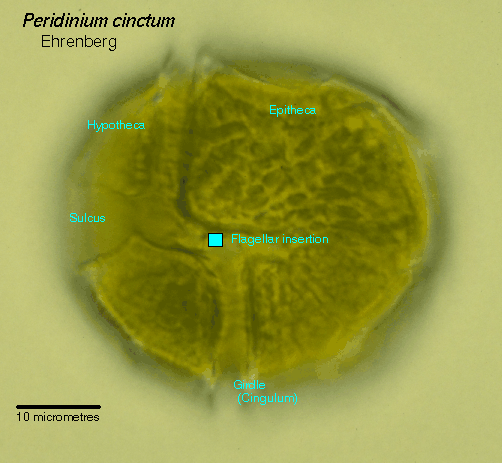
Peridinium cells may be present in the environment as planktonic cells, motile by means of eukaryotic flagella, or thick-walled nonmotile cysts usually found in bottom sediments.

The swimming cells may range in size from about 10 to nearly 100 micrometers in length. The cells are roughly top-shaped, with a conspicuous cell covering ("theca") consisting of around 20 abutting plates. Because these plates are present, Peridinium is treated as one of the "armored" dinoflagellates.
The plate junctions ("sutures") are not often visible in living cells. These plates are made of a complex polysaccharide, formerly believed to be cellulose. An equatorial groove in the plates (the "girdle") holds the transverse flagellum. Another, posteriorly-directed groove (the "sulcus") holds the longitudinal, or sulcal, flagellum. The insertion point of the two flagella is at the intersection of the girdle and sulcal groove. This intersection is defined as the ventralsurface of the cell. The "epitheca" is anterior to the girdle, the "hypotheca" is posterior to the girdle. The precise arrangement of thecal plates ("plate tabulation"), and the ornamentation of the plates, define the genus Peridinium and its species. Plastids, when present, are golden-brown in color.
Cysts have thicker walls than swimming cells. Some cysts, including the relatively short-lived hypnozygotes that participate in sexual reproduction, have similar plate tabulation to swimming cells. Other, presumably longer-lived cysts have plate tabulations that do not resemble those of swimming cells. The latter type of cyst includes the hystrichospheres of palynology; these are the only dinoflagellate remains found in the fossil record.
Return to summary information